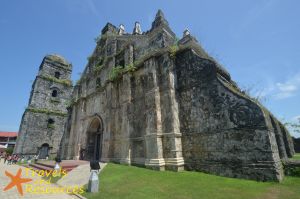 The Saint Augustine Church of Paoay, which is also known simply as Paoay Church, is one of the oldest churches in the Philippines. Started in 1694 by the Augustinian Friar Antonio Estavill and finished in 1710, this Baroque Church took about 16 years to build.
The Saint Augustine Church of Paoay, which is also known simply as Paoay Church, is one of the oldest churches in the Philippines. Started in 1694 by the Augustinian Friar Antonio Estavill and finished in 1710, this Baroque Church took about 16 years to build.
[As old churches go, this may still be considered to be quite fast.]
I’ve actually passed by this church several times on trips this far up North, but never had the time to stop by and look it over. This time around, my wife and I stayed a night at Fort Ilocandia and were planning another night in Vigan, giving us the opportunity to finally stop and give the place a look.
Table of Contents
Baroque Architecture
I must admit to encountering the word “Baroque” quite a few times in my readings. Unfortunately, I never really understood what it exactly meant. All I knew was that the word is associated with something really old and very ornate.
[My history teachers must be slamming their heads on the nearest wall as they read this.]

Exterior
In an attempt to redeem myself in eyes of my teachers, I took a little time to research its meaning on the internet and came up with the following definitions:
The Merriam-Webster Dictionary defines it as” relating to a dramatic style of art and music that was common in the 17th and early 18th centuries and that featured many decorative parts and details.”

Wall
The Oxford Dictionary defines it as a French word “Relating to or denoting a style of European architecture, music, and art of the 17th and 18th centuries that followed mannerism and is characterized by ornate detail. In architecture the period is exemplified by the palace of Versailles and by the work of Bernini in Italy. Major composers include Vivaldi, Bach, and Handel; Caravaggio and Rubens are important baroque artists.”
[Ha! I wasn’t too far off!]
Anyway, getting back to the topic at hand, Paoay Church is one of four Baroque Churches in the Philippines that has been listed as a World Heritage Site by the United Nations Educational, Scientific and Cultural Organization, or UNESCO, back in the year 2003.
Adapted to Philippine Conditions
One of the things that helped to bring about the diverse landscape of the Philippines is that it is located in the Ring of Fire in the Pacific Ocean. I understand that approximately 90% of all earthquakes in the world can be traced to this ring.

Buttresses
Based on a study conducted by the National Disaster Coordinating Council of the Republic of the Philippines, the country experiences about 887 earthquakes every year. Some are very light tremors that rarely do any damage and hardly felt by the population. While others can be extremely dangerous, such as the ones that damaged Paoay Church in the years 1865 and 1885.
Without the benefit of all this information, the Spanish, during their 400-hundred year occupation of the Philippines, still recognized the threat that earthquakes posed to the structures they built. Instead of merely copying building techniques in Spain, they adapted it to better handle tectonic movements.
In the case of Paoay Church, the biggest change may be the use of huge buttresses, numbering 24 in total, to support the sides and rear walls of the church. And when I say huge, I mean they are massive.

Tower
Standing about two-thirds the height of the church, these massive buttresses are impossible to miss. And since they were created in the 17th to 18th centuries, they follow the beautiful slope of the front facade.
Another thing that stands out with Spanish-made churches is that many of them were constructed from indigenous materials. Take the case of Baclayon Church in Bohol. When it was completed back in 1727, the materials used for its construction included coral stones and egg white.
Being from the same period, Paoay Church had much of the lower structure constructed out of coral, but used sand mixed with the juice from sugarcane to help keep everything together. In addition to this, brick was used for the upper portion to give it that distinctive look found on many Ilocos Norte structures over the centuries.
[These old building materials have lasted centuries, while modern materials haven’t had the chance to prove themselves yet.]
Still keeping earthquakes in mind, the bell tower was not connected to the main church. This was done so that if an earthquake were to damage it, the main church could be spared from any fallout.
Church Interior
I understand that the ceiling of Paoay Church used to be filled with paintings that were reminiscent of the Sistine Chapel in Rome. However, a couple of earthquakes and the ravages of time appear to have conspired to bring all that artwork down.

Interior
The ceiling and roof of today’s Paoay Church is now composed of exposed metal frames and sheets of galvanized steel to protect its interiors from the elements.
[I am hoping that a full-blown restoration can push through to return it to its old glory.]
Looking down, the floor is composed of tiles that appear to be from the 20th century. And while they may not appear to come from the 17th century, the tiles appear to be laid out very well to provide a smooth floor for churchgoers to walk on.

Pulpit
The many pews appear to be made of thick wood that is rarely found today. And the paint used is the typical brown color and several layers thick to help preserve the wood underneath.
One of the most exquisite example of wrought iron work from 1891 is the Pulpit that located about a third of the way to the altar. Mounted on a post above the congregation, this is where priests in the old days would conduct their sermons from.
[It was actually my Mom who told me about this as she still witnessed it being used during her childhood.]

Altar
Modern Catholic Churches do not have this raised Pulpit anymore as Catholic priests now provide their sermon from a Pulpit near the alter so the congregation at the front of do not have to twist around anymore.
Finally, at first glance, the altar looks quite simple, especially when it is compared to other churches such as the Parish of the Holy Rosary in Pampanga. However, look a little closer and the gold ornate designs of the Pulpit on the left, the Alter in the center, and the Lectern on the right pop out. Look a little further, and the candle holders behind the Altar as just as ornate.
[It is only upon close inspection that the beauty is revealed.]
Final Thoughts

Interior
One of the good things about Saint Augustine Church of Paoay is that it is a functioning one, meaning that mass continues to be held regularly in Ilocano, the local dialect, and English.
[This is remarkable for a 300 year old church.]
Unfortunately, the church needs some help. The structure needs to be worked on to keep it from sustaining damage from future earthquakes, so I am hoping that restoration efforts be started as soon as possible.
Well, that’s it for our quick stop at Saint Augustine Church of Paoay. Being just 20 minutes away from Fort Ilocandia means that we still have about an hour and forty minutes to get to Vigan for another adventure.
Must Do’s
- Say a prayer and make three wishes if this is the first time you have entered the church.
Must Don’ts
- Do not make noise inside or outside the church.
- Do not litter inside or outside the church.


Comments are closed